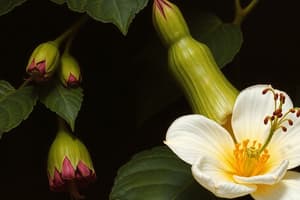Podcast
Questions and Answers
What is the primary function of the style in plant reproduction?
What is the primary function of the style in plant reproduction?
- To protect the ovary from damage
- To produce pollen
- To connect the stigma to the ovary (correct)
- To attract pollinators
Which of the following is NOT a function of pollination?
Which of the following is NOT a function of pollination?
- Transfer of pollen from anther to stigma
- Attraction of pollinators
- Fusion of gametes (correct)
- Production of seeds
What is the primary purpose of the sepal in flowering plants?
What is the primary purpose of the sepal in flowering plants?
- To protect the reproductive organs (correct)
- To attract pollinators
- To produce pollen
- To facilitate fertilization
What is the outcome of fertilization in flowering plants?
What is the outcome of fertilization in flowering plants?
What is the function of the anther in plant reproduction?
What is the function of the anther in plant reproduction?
What is the ultimate result of the reproductive process in flowering plants?
What is the ultimate result of the reproductive process in flowering plants?
What is the significance of genetic recombination in flowering plants?
What is the significance of genetic recombination in flowering plants?
What is the function of the ovary in flowering plants?
What is the function of the ovary in flowering plants?
Flashcards are hidden until you start studying
Study Notes
Overview of Sexual Reproduction in Flowering Plants
- Sexual reproduction in flowering plants involves the production of gametes (sperm and egg cells) and the fusion of these cells to form a zygote.
- This process allows for genetic variation and adaptation in plant populations.
Structures Involved in Sexual Reproduction
- Flowers: The reproductive structures of flowering plants, consisting of four whorls:
- Sepals: Protective, green, leaf-like structures.
- Petals: Colorful, attractive structures that attract pollinators.
- Stamens: Male reproductive organs, consisting of:
- Anthers: Produce pollen, containing sperm cells.
- Filaments: Support the anthers.
- Carpels: Female reproductive organs, consisting of:
- Stigma: Receives pollen.
- Style: Connects stigma to ovary.
- Ovary: Contains ovules, where fertilization occurs.
The Reproductive Process
- Pollination: Transfer of pollen from anther to stigma, often facilitated by pollinators like bees or butterflies.
- Fertilization: A pollen grain germinates, producing a pollen tube that delivers sperm cells to the ovary.
- Fusion of Gametes: A sperm cell fuses with an egg cell in an ovule, forming a zygote.
- Seed Development: The zygote develops into an embryo, surrounded by endosperm tissue, which provides nutrients.
- Fruit Formation: The ovary wall develops into a fruit, which protects and disperses the seed.
Importance of Sexual Reproduction in Flowering Plants
- Allows for genetic recombination, increasing genetic diversity.
- Enables adaptation to changing environments.
- Facilitates the evolution of new plant species.
Sexual Reproduction in Flowering Plants
- Sexual reproduction allows for genetic variation and adaptation in plant populations.
Structures Involved in Sexual Reproduction
- Flowers are the reproductive structures of flowering plants, consisting of four whorls:
- Sepals: Protective, green, leaf-like structures.
- Petals: Colorful, attractive structures that attract pollinators.
- Stamens: Male reproductive organs, consisting of anthers and filaments. + Anthers: Produce pollen, containing sperm cells. + Filaments: Support the anthers.
- Carpels: Female reproductive organs, consisting of stigma, style, and ovary. + Stigma: Receives pollen. + Style: Connects stigma to ovary. + Ovary: Contains ovules, where fertilization occurs.
The Reproductive Process
- Pollination: Transfer of pollen from anther to stigma, often facilitated by pollinators like bees or butterflies.
- Fertilization: A pollen grain germinates, producing a pollen tube that delivers sperm cells to the ovary.
- Fusion of Gametes: A sperm cell fuses with an egg cell in an ovule, forming a zygote.
- Seed Development: The zygote develops into an embryo, surrounded by endosperm tissue, which provides nutrients.
- Fruit Formation: The ovary wall develops into a fruit, which protects and disperses the seed.
Importance of Sexual Reproduction in Flowering Plants
- Allows for genetic recombination, increasing genetic diversity.
- Enables adaptation to changing environments.
- Facilitates the evolution of new plant species.
Studying That Suits You
Use AI to generate personalized quizzes and flashcards to suit your learning preferences.




